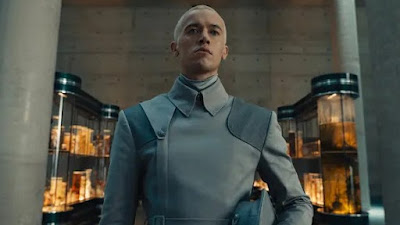Years before he became the tyrannical president of Panem, 18-year-old Coriolanus Snow remains the last hope for his fading lineage. With the 10th annual Hunger Games fast approaching, the young Snow becomes alarmed when he's assigned to mentor Lucy Gray Baird from District 12. Uniting their instincts for showmanship and political savvy, they race against time to ultimately reveal who's a songbird and who's a snake.
In The Hunger Games cinematic universe, The Ballad of Songbirds and Snakes emerges as an ambitious prequel directed by Francis Lawrence and penned by Michael Lesslie, Michael Arndt, and Suzanne Collins. However, the noticeable absence of Jennifer Lawrence, a key figure in the prior films, sets the stage for a narrative unfolding decades before the emergence of Katniss Everdeen.
The storyline unfolds 64 years before the inaugural Hunger Games film, situated in a post-war Panem. It paints a portrait of an almost desolate Capitol and introduces us to an 18-year-old Coriolanus Snow, portrayed by English actor Tom Blyth. Snow, a naive student at the prestigious Capitol Academy, becomes entangled in a significant twist commemorating the tenth Hunger Games anniversary. The film introduces Lucy Gray, a vibrant and rebellious tribute played by Rachel Zegler, infusing her character with Southern charm and a penchant for spontaneous song.
With a runtime of two hours and forty minutes, the film delves beyond the Games, chronicling Snow's transition from an earnest participant to the mastermind orchestrating the brutal Hunger Games. However, this transformation feels hasty and lacks focus, diminishing the impact of Snow's evolution.
Ballad endeavours to explore a Panem on the brink of moral ambiguity, a society not entirely desensitized to the gruesome spectacle of the Games. It aims to reflect on media consumption and societal indoctrination, particularly the affluent's relish in the downfall of the less fortunate.
In its attempt to humanize Coriolanus Snow, the film encounters stumbling blocks. Uncharacteristic hesitancy and a lack of confidence overshadow the ruthless character, causing unnecessary confusion and diluting the impact of his decisions. This misguided effort to elicit sympathy undermines the portrayal of a notoriously ruthless figure.
Rachel Zegler's portrayal of Lucy Gray showcases her remarkable singing range, adding depth to her character. However, the film grapples with pacing issues, notably in the third act, where a sudden shift in tone seems more focused on setting up future sequels than serving the current narrative. The film becomes, in essence, a tale of two halves.
Ballad hesitates to fully commit to exploring Snow as a twisted antihero, instead clinging to a Romeo and Juliet-style romance. This diversion, occasionally affecting, primarily serves as a distraction from the intriguing road-to-ruin story promised by the premise.
Director Francis Lawrence, helming most Hunger Games films, closely adheres to the source material, presenting challenges. The second act lingers excessively within the Games, while the third act takes an unexpected detour away from the Capitol. Both choices contribute to a bloated running time exceeding 2 1/2 hours, diluting the tension.
As the Games conclude, the film delves into Snow's villainous origins, presenting decisions detached from the character's established persona. Dark choices appear rushed, lacking the necessary build-up for plausibility. The film struggles to find its footing, seemingly caught off guard by the necessity to narrate Snow's turn towards malevolence.
The decision to consolidate diverse narratives into a single film raises questions, especially when juxtaposed with the split of Mockingjay into two parts. Despite an abundance of characters, the film's premise doesn't significantly deviate from its predecessors, adhering to the formula of oppressed survivors overcoming tyrannical authorities in gladiatorial trials.
While some violence escalates with a darker tone, the action outside the relationship drama fails to captivate. Ballad retraces familiar beats from earlier films but with subpar editing and a scarcity of sci-fi elements.
The Ballad of Songbirds and Snakes strives to chart a unique course in the Hunger Games saga. Despite commendable performances, particularly from Rachel Zegler, and the exploration of moral ambiguity, the film succumbs to pacing issues, a conflicted portrayal of its protagonist, and a narrative discord hindering its overall impact.
The absence of Jennifer Lawrence is evident, and her lack of presence is not sufficiently countered, prompting contemplation on whether this prelude added a harmonious melody to the Hunger Games symphony or if it lost itself in discordant notes.
The Hunger Games: The Ballad of Songbirds & Snakes was released in NZ cinemas on November 16, 2023










.tif)


































